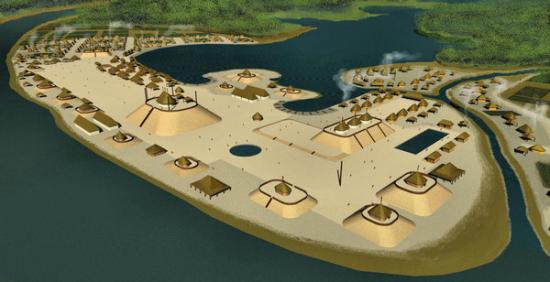Richard Thornton
Source - https://www.examiner.com/article/bon-secour-was-part-of-a-lost-gulf-coast-culture?cid=rss

There were originally several large Native American towns on the Gulf Coast. Only those sites protected from hurricanes are still visible. Credits: VR image by Richard Thornton
Bon Secour National Wildlife Refuge is on the Gulf Coast of Alabama. It is near Gulf Shores, AL, about 36 miles (58 km) southeast of Mobile and 32 miles (52 im) west of Pensacola, FL. Bon Secour is about a days walk from Perdido Bay, where numerous underwater mounds and artifacts have been found.
One of the most pervasive myths in American history books are the assumptions that it indigenous peoples always lived in the same location where the first came in direct contact with frontier settlers. Tennesseans think of the Chickasaws as the occupants of the extreme western edge of the state, when up until the early 1700s, their villages spanned almost the entire breadth of the Volunteer State, plus much of northern Alabama and several small provinces in Georgia.
Many Floridians think of the Seminoles as a “Swamp People,” indigenous to the extreme southern part of their state. They would be shocked to see early colonial maps which show the branches of the Creek Indians, who became the core of the Seminoles, living in the Smoky Mountains of North Carolina and Tennessee.
The same myth is true of Alabama. Alabamans think of the Creek Indians as “their Indians.” Until 1763 true Muskogee-Creeks were confined to a relatively narrow band along the eastern border of that future state. Creek villages and families did migrate to the Coastal Plain of Alabama in the late 1700s, but it is unlikely that they were the direct descendants of the peoples who built towns with mounds along the coast.
Gulf Coast’s original inhabitants
There are literally thousands of earthen mounds in the Southeast, but only a few survive that are in eyesight of the Gulf of Mexico, Atlantic Ocean, or even a bay. This does not mean that they never existed. The water level of the Gulf Coast has been steadily rising for thousands of years. What was solid land, one to two thousand years ago, is now under the water. What’s left of relative low mounds is below the water’s surface.
There is another explanation for the disappearance of mounds on the coast of Mississippi, Alabama and Florida. The Gulf and South Atlantic Coasts are is intermittently subjected to violent hurricanes which severely alter the landscape of the ocean’s edge each time they strike. The outlets of major rivers such as the Mississippi, Mobile and Apalachicola are constantly dumping silt on the landscape. Often, the only evidence that beachcombers see of these ancient towns are concentrations of pottery shards in the sand or marsh peat. Especially, along the Gulf Coast.
There is one bay, however, in which for unknown reasons, there are numerous earthen mounds still existing. They are mostly at the edge of the bay and under shallow water. None have been excavated by professional archaeologists. Very few, if any, have been even assigned formal numbers in Florida’s archaeological site index file. The bay is immediately east of Pensacola. Its name is Perdido Bay. Ironically, “perdido” means “lost or hidden” in Spanish. Could this “hidden bay” also be hiding vestiges of the explorations of ancient Maya traders? This question cannot be answered until these mounds are studied by professional archaeologists.
When Spanish explorer, Pánfilo de Narváez sailed into Pensacola Bay, FL in 1528, he was told that the name of the province that formed a crescent from Mobile Bay, AL down to Cedar Key, FL was a word that the Spanish recorded as Amichel. The Pensacola Indians, who lived there, apparently didn’t know what the word meant. They called the bay area itself, Ochausi, which the Spanish recorded as Ochuse. The Spanish described them as a primitive people, who only grew small gardens and subsisted on seafood, wild fruit and acorns.
The aboriginal peoples of the Gulf Coast spoke several languages, most of which are extinct now. The oldest occupants appear to have been a branch of the Siouan peoples. Their language, called Palache or Apalache (Biloxi in French) mixed Siouan, Maya, Totonac and Muskogean words. Most of the Palache (or Apalache) originally lived in the North Georgia Mountains, near the gold fields. Some people spoke a language similar to Choctaw. Others spoke a language the mixed Choctaw and Muskogee called Chatot. Others spoke a Muskogean language that had many Mesoamerican words in it, called Itsate.
In the five centuries since Pensacola’s discovery, scholars have debated the meanings of these two Native words, Amichel and Ochuse. Ochausi is identical to a Creek Indian word and very similar to a Choctaw Indian word, but Amichel didn’t seem to come from any known Native American language. On the other hand, the meaning of Pensacola was obvious. Pensacola means “Live Oak People” in the Apalachicola-Creek language. It is known that unlike most Creek tribes, the Pensacola harvested Live Oak acorns instead of growing corn. The Wahale Creeks (Guale) of coastal Georgia also were dependent on acorns for most of their carbohydrates.
Even before the Spanish first explored the Gulf Coast of North America, though, their presence in the Caribbean Basin had devastated Native populations. A horrific smallpox plague struck the Yucatan Peninsula in 1500 AD. In the boats and canoes of traders smallpox was spread northward along the Gulf Coast of Florida and then, apparently the coasts of present day Alabama and Mississippi. When the first Spanish explorers cruised the Gulf Coast over two decades later, they observed large, abandoned towns near where the cities of Fort Walton, Pensacola and Mobile stand today. It is quite possible that the occupants of these towns were an entirely different ethnic group than those who survived. They were wiped out by European diseases because they lived in compact towns. Who these “lost” people were, we will probably never know for sure.